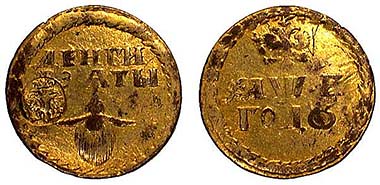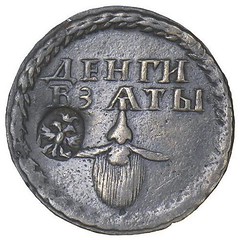
PREV ARTICLE
NEXT ARTICLE
FULL ISSUE
PREV FULL ISSUE
MORE ON THE RUSSIAN BEARD TOKENSRich Hartzog writes: I forwarded the article on Russian Beard Tax countermarks to Dr. Gregory Brunk, noted countermark researcher.
Thanks! Dr. Brunk's response is below.
-Editor
Bialkowski, A. 1973. Brodowy zeton (Genuine and Fake Beard Tax Tokens). Biuletyn Numizmatyczny 1973: 170-171. Chizhov, S. I. 1900. Borodovie znake. Trudy Moskovskago Numizmaticheskago Obshtchestwa 1900: 331-352. Jensen, J. S. 1975. Russiske skaegtegn fra Peter den Stores tid (Peter the Great Beard Tax Tokens). Montsamlernyt 1975 (Sept): 240-242. Hawkins, W. 1844. Beard Tax Tokens. Numismatic Chronicle 1844 / 1845: 153-155. Zander, R. 1948. Russian Beard Tokens. Numismatist 1948: 842-847. Reprinted in Journal of the Russian Numismatic Society 1983 (Fall): 14-23.
Ursula Kampmann forwarded this article from CoinsWeekly with additional information on the beard tokens of Peter I. Thanks!
-Editor

On September 5th, 1698, Peter – who was later to be called The Great – returned from his educational tour in the metropolises of Europe to Moscow. Of course, all important officials, the flunkeys and all those hoping for the Tsar to confer a favour on them gathered at the court the next morning. But instead of talking to them about Russia’s political future, Peter did something totally unexpected. He pulled a long and sharp razor from his bag and began to shave the commander in chief of the army. The latter was too stunned to react. The next in line followed, an important politician, a boyar stemming from the eldest and noblest Russian family. One Russian nobleman after the other was shaved except for three people. Peter spared only the Patriarch, a very old man and his own guardian. At first, the shaving skills of the Tsar were restricted to those living closest to him. But shortly afterwards, Peter gave the order for the ordinary people to follow the example of the big wigs. The Tsar imposed a prohibition for every inhabitant of his country to wear a beard. Exceptions were made only for churchmen and peasants. Officials were sent out to supervise the ukase’s implementation and to personally shave anybody refusing to obey on the spot. But Russia would not be Russia if the officials had not been willing to miss a beard for a small reward. Buying the illegal tolerance, however, could cost bearded men dearly. After all, each and every official encountering a bearded man was entitled to shave. Peter saw that abuse and his subjects’ willingness to buy the beards with money. The westernization of the Russian nobility being accomplished, he could be generous with the commoners. Peter enacted a new law that enforced the peasants to shave, too, but allowed all Russians who did not want to part with their beards to acquire the right to keep them for a tax. It was a progressive tax: the humble peasant paid two kopeks, a rich merchant up to 100 rubles. In return, they were given a copper token with the image of a beard and the Russian words “tax paid”. To read the complete article, see: Peter the Great as his nation’s barber (www.coinsweekly.com/en/Peter-the-Great-as-his-nations-barber/8?&id=70&type=a)
To read the earlier E-Sylum article, see:
QUERY: RUSSIAN BEARD TAX TOKEN COUNTERSTAMPS
(www.coinbooks.org/esylum_v15n46a19.html)
The Numismatic Bibliomania Society is a non-profit organization promoting numismatic literature. See our web site at coinbooks.org. To submit items for publication in The E-Sylum, write to the Editor at this address: whomren@gmail.com To subscribe go to: https://my.binhost.com/lists/listinfo/esylum All Rights Reserved. NBS Home Page Contact the NBS webmaster 
|
